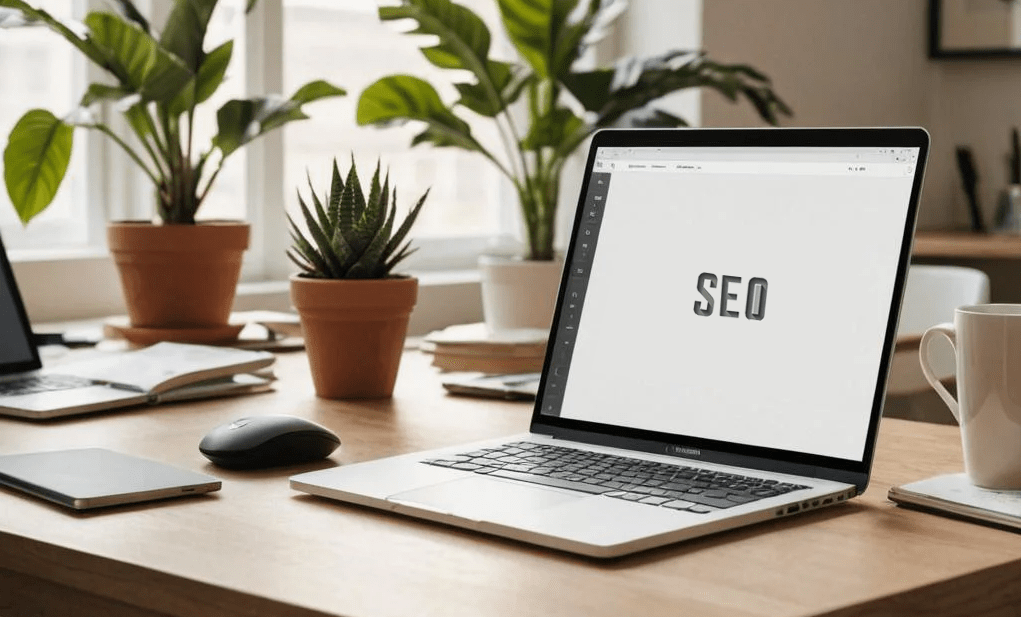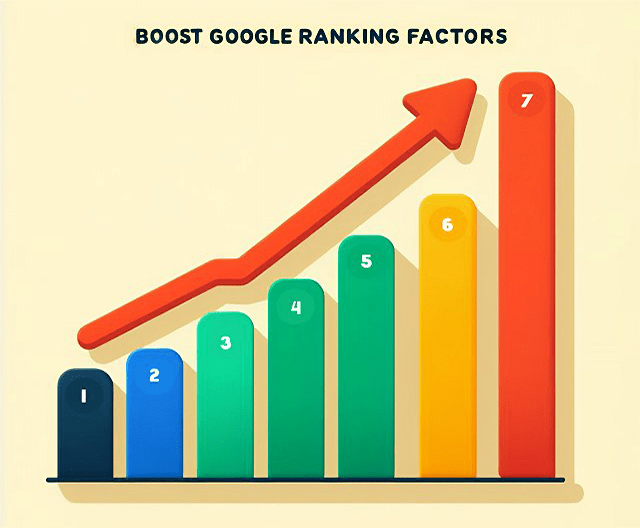
Introduction – How to Boost Google Ranking
Contents
In the ever-evolving landscape of search engine optimization (SEO), understanding and leveraging top Google’s ranking factors is crucial for any website aiming to achieve, maintain high visibility in search engine results pages (SERPs). This article delves into the core ranking factors that tap into Google’s algorithm and offers actionable strategies to boost your website’s ranking in Google.
| Core Factors | On-Page Techniques | Off-Page Strategies | Technical SEO |
|---|---|---|---|
| Keywords and Content Optimization | Use of Headers and Sub-headers | Backlink Building | Site Speed Optimization |
| Quality Meta Tags | Internal Linking | Social Media Signals | Mobile-Friendliness |
| Image Optimization | Content Quality | Page Experience Metrics |
Below are important and essential factors to implement in order to optimize your site and improve Google SEO ranking:
1. Content Quality and Relevance
High-Quality Content
Content remains the cornerstone of SEO. High-quality, well-structured content that addresses user intent not only improves rankings but also enhances user satisfaction. Investing in original and valuable content pays off in the long run.
Content remains king in the realm of SEO. Consequently, Google prioritizes content that has the following attributes:
- Informative and Valuable: Provide comprehensive information that addresses the user’s query.
- Original and Unique: Avoid duplicating content from other sources. Originality is key.
- Well-Researched: Support your content with data, statistics, and credible sources.
Keyword Optimization
Keywords are the bridge between user queries and the content you provide. Effective keyword optimization involves:
- Keyword Research: Use tools like Google Keyword Planner, Ahrefs, or SEMrush to identify relevant keywords.
- Strategic Placement: Incorporate keywords naturally in titles, headers, and throughout the content.
- Long-Tail Keywords: Focus on specific, longer phrases that match user intent more precisely.
Content Structure
A well-structured article enhances readability and user experience. Utilize:
- Headings and Subheadings: Organize content into sections with H1, H2, H3 tags.
- Bullet Points and Numbered Lists: Break down information for easy scanning.
- Multimedia Elements: Incorporate images, videos, and infographics to enrich content.
Expert analysis reveals that websites investing in content marketing see an average of 6x higher conversion rates compared to those that do not. Furthermore, 82% of marketers actively use content marketing as a core strategy, emphasizing its critical role in driving organic traffic and engagement.
2. On-Page SEO

On-page SEO is foundational to any SEO strategy. Optimized titles, meta descriptions, and URLs improve both user experience and search engine understanding of your content. Internal linking further enhances site structure and authority distribution.
Title Tags and Meta Descriptions
Title tags and meta descriptions are critical for both SEO and user engagement:
- Compelling Titles: Create concise, engaging titles that include primary keywords.
- Descriptive Meta Descriptions: Summarize the content accurately, enticing users to click through.
URL Structure
SEO-friendly URLs are descriptive and easy to read:
- Short and Descriptive: Avoid long, complex URLs. Use hyphens to separate words.
- Keyword Inclusion: Include primary keywords in the URL.
Internal Linking
Internal links help distribute page authority and guide users through your site:
- Relevant Links: Link related content to provide additional value.
- Anchor Text: Use descriptive anchor text that includes relevant keywords.
Studies indicate that websites with optimized title tags and meta descriptions see a 30% increase in organic traffic. Additionally, a well-structured internal linking strategy can improve crawl efficiency by up to 40%, leading to better indexation and higher rankings.
3. Technical SEO
Technical SEO ensures that your website is accessible, fast, and secure. Mobile-friendliness and page speed directly impact user experience and are critical for maintaining competitive rankings.
Mobile-Friendliness
With Google’s mobile-first indexing, ensuring your site is mobile-friendly is essential:
- Responsive Design: Use a design that adapts to various screen sizes.
- Mobile Usability: Ensure buttons, links, and text are easily accessible on mobile devices.
Page Speed
Page speed is a direct ranking factor and impacts user experience:
- Optimize Images: Use compressed images to reduce load times.
- Minimize JavaScript and CSS: Reduce the size and number of files to improve speed.
- Leverage Browser Caching: Enable caching to speed up loading for returning visitors.
Secure Websites (HTTPS)
Secure websites not only protect users but also helps to have a slight ranking advantage. Site security is a priority for Google:
- SSL Certificates: Ensure your website uses HTTPS to protect user data and enhance trust.
Research shows that a one-second delay in page load time can lead to a 7% reduction in conversions. Moreover, over 50% of global web traffic now comes from mobile devices, making mobile optimization a critical factor for SEO success.
4. Off-Page SEO
Off-page SEO, particularly backlinks, remains a significant ranking factor. Building a portfolio of high-quality backlinks establishes your site’s authority. Social signals, while indirectly influential, increase Google ranking, drive traffic and engagement, contributing to overall SEO success.
Backlinks
Backlinks are a significant ranking factor, indicating the authority and relevance of your site:
- Quality over Quantity: Focus on acquiring backlinks from reputable, high-authority sites.
- Natural Link Building: Avoid black-hat techniques like buying links. Aim for organic growth through quality content and outreach.
Social Signals

While the direct impact of social signals on rankings is debated, their importance in driving traffic and engagement is clear:
- Social Media Presence: Share content on platforms like Facebook, Twitter, and LinkedIn.
- Engagement: Encourage likes, shares, and comments to boost visibility.
According to Moz, backlinks account for over 20% of the ranking factors in Google’s algorithm. High-quality backlinks not only improve rankings but also drive referral traffic and enhance domain authority.
5. User Experience (UX)
User experience is increasingly critical in SEO. Metrics like bounce rate, dwell time, and Core Web Vitals directly affect how users interact with your site. Enhancing UX not only boosts rankings but also fosters user loyalty and satisfaction.
Bounce Rate and Dwell Time
Google considers user engagement metrics:
- Engaging Content: Create content that captures interest and keeps users on your page.
- Easy Navigation: Ensure your site is easy to navigate with a clear structure.
Core Web Vitals
Core Web Vitals are a set of metrics related to speed, responsiveness, and visual stability:
- Largest Contentful Paint (LCP): Measure loading performance.
- First Input Delay (FID): Measure interactivity.
- Cumulative Layout Shift (CLS): Measure visual stability.
Google’s emphasis on Core Web Vitals reflects its commitment to user experience. Websites that meet or exceed these metrics are more likely to rank higher. An improvement in LCP from 2.5 seconds to 1.5 seconds can result in a 20% increase in conversions.
FAQs
Q: What are the most important ranking factors? A: Keywords, content quality, backlinks, site speed, and user experience.
Q: How can I improve my site speed? A: Compress images, use a good hosting service, and optimize your site’s code.
Q: Why are backlinks important? A: They act as votes of confidence from other sites, helping to boost your credibility and ranking.
Conclusion

Boosting your website’s ranking in Google involves a multifaceted approach. By focusing on high-quality content, optimizing on-page and technical SEO elements, building authoritative backlinks, and enhancing user experience, you can significantly improve your site’s visibility in search results. Remember, SEO is an ongoing process that requires regular updates and adjustments to stay ahead in the competitive digital landscape.

